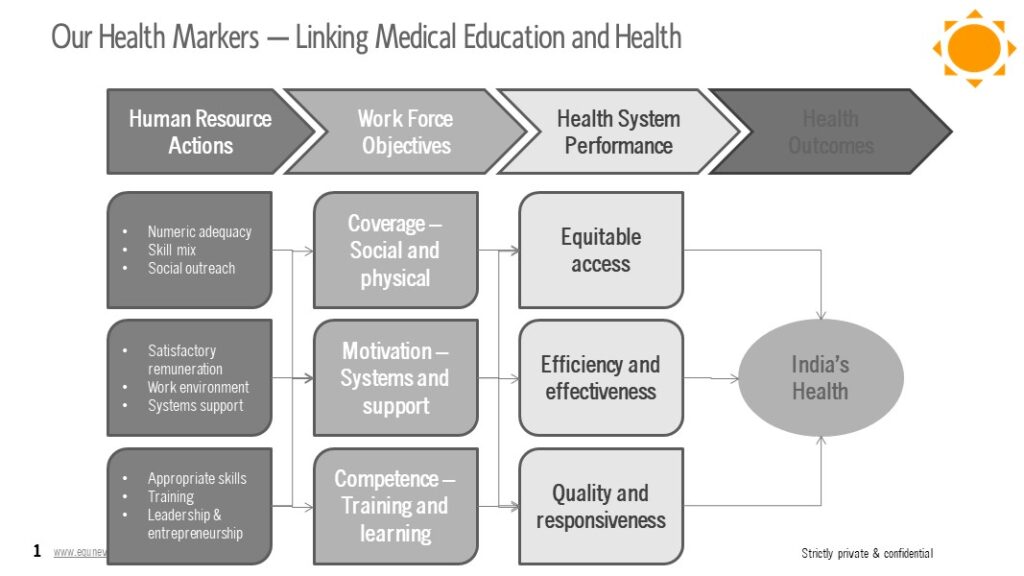Preamble
Operation Ganga was an evacuation operation by the Government of India to evacuate the Indian citizens amidst the 2022 Russian invasion of Ukraine, who had crossed over to neighboring countries. This involved transport assistance from the neighboring countries of Romania, Hungary, Poland, Moldova, Slovakia to reach India. Over 20,000 medical students were evacuated in Operation Ganga. I have been writing and talking about it over the last 10 years. Let me outline the magnitude of the situation at hand. India constitutes ~18% of world’s population. From here things become a bit trickier. We have world’s 21% disease burden. ie. One-sixth higher proportion of people falling sick. On the clinical manpower shortages, we just have around 8% of the total global labour force of doctors, nurses and healthcare workers to address the 20% of the global disease burden we carry with our people. We are short by 5 lakh doctors, 20 lakh nurses and 30 lakh short of other health workers. Fortunately, we are a net exporter of nurses to the world so we have to also back fill the gaps of nurses leaving out of India for those remaining in India. Coming to the capital to address these gaps, we require close to Rs 30 lakh crores or $430 billion to come to the global average of hospital beds. Another Rs 2 lakh crores or $29 billion is required to build capacity for healthcare manpower. Therefore the total investment is approx $460 billion. To give you the magnitude, 165 countries in the world had a GDP of less than $460 billion in 2018. Given the shortage of merit quota seats in Indian medical colleges, students have to migrate abroad for pursuing their medical education. We need an upstream Operations Himalaya in earnest.
Vision for Operations Himalaya
There is a saying “9 men cannot make a baby in 1 month”. Similarly, students enrolled into medicine today will add incrementally to the workforce in next 4 years. The silver lining is that this capacity building spend would lead to $1.45 trillion of additional incremental to the GDP after 5 years as 1 incremental bed capacity creates 28 jobs over its lifetime. In other words healthcare economy in India as a standalone would itself be #16 nation in terms of GDP. The table outlines the future of Medical Education.
| What is the Future of Medical Education? As per the Milbanks Report on the Future of Academic Medicine 2025, there are 3 key trends that are impacting medical education Digitalization of Healthcare new science and technology, particularly genetics and IT speed of internet and digitalization unimportance of distances 24/7 society lack of agreement on where healthcare begins and ends Personalization of Healthcare rich and poor gap seeking “wellness” and rise of self-care & sophistication increasing anxiety about security and ethical issues emergent diseases Globalization of Healthcare gap between what can be done and what can be afforded increasing accountability of all institutions loss of respect for experts (more so after the pandemic) economic and political rise of India and China |
There needs to be a top-down vision for expanding the supply of clinical manpower in India which needs to be tied to the healthcare outcomes our healthcare system needs to achieve. The following framework which I presented earlier outlines the process for setting up the vision.

In the past I have defined these as the 3 A’s.
- Affordability: The Cost and Benefits of Developing Careers in Healthcare in India
- Accessibility: Providing trained staff in different parts of India
- Assurance: Training to medical professionals meets global standards to perform in any healthcare system
Key Issues: Healthcare Manpower Economics:
It costs approximately Rs 2 crores per seat to set up a medical college for 100 seats in India. While this may be economical, investments in medical colleges and doctor training is a lengthy process; therefore, changes implemented to alter supply do not have immediate effects on the supply of trained healthcare professionals. A recent estimate reveals that as many as 40% of rural posting by trained medical graduates and post graduates in different states in India are not fulfilled. There is a huge shortage of gynaecologists, cardiologists and child specialists in rural hospitals in the government sectors. Hence the government announcement to increase the supply of medical graduates may still not address the accessibility issue. We may end up importing clinical manpower from lower cost destinations if we are not able to produce these cost effectively in India.
Medical education is supposed to be overseen by the different Councils of India, which is responsible for ensuring the quality of both the infrastructure and the professors at India’s medical institutes and also provide assurance that they meet the global standards. Since demand is high, it is difficult for schools to retain faculty over the long term, which creates a lack of continuity in both the school’s practices and its policy. The plethora of new and underequipped medical schools will create more doctors and healthcare professionals on paper, but will lower the quality of the doctors produced, further exacerbating the preexisting shortage. So, while attempting to alleviate a shortage of doctors, India has managed to create a completely new crisis on top of the preexisting one – the shortage of teaching professionals in these medical collages. Various estimates put this somewhere between 75,000 to 100,000 trained teachers and professions currently.
Finally,
Mere policy announcement for opening up more medical colleges in India is not the panacea for solving the shortages in the supply of healthcare professionals and the people to train healthcare professionals. It is time we look at the issues holistically and plan for the future by going upstream towards the Himalaya from the current emergency evacuation of Operation Ganga!
Also Read Article published in my Column – A Dose of IT published in Deccan Chronicle and Asian Age – 14 February 2011
Rs 1 Crore crores Human Capital Impact – A Generation Lost
My presentation at the 21st World Quality Congress a fortnight ago just highlighted the human capital impact due to healthcare and education in India. A whopping Rs 92,28,230 crores to the Indian economy at net present value! This is like creating over 1500 TCS or Infosys or Wipro in today’s size overnight in our economy.
Let us understand, although India has 18% of world’s student population that is the largest in the world, its policy and direction on higher education, including medical and health sciences sector is not clearly articulated towards inclusive development. Regulation, size of funding to this sector, both public and private is one of the key determinants of India’s ability to generate wealth (GDP). Moreover sectorial priorities and directions in sectors such as health sciences, infrastructure if not clearly addressed could create future crisis in the economy and further impede economic growth.
On the demand side, we already know that India contributes to 18% of world’s population, however its share of world’s disease burden is 20%. Hence to treat the increased disease burden, India requires incremental human capital of doctors, nurses and other health workers. But the issues get very grave for India. We have around 8% of world’s doctors, nurses and health workers. Hence we may have to create more human capital in healthcare to treat India’s disease burden. What’s more, of the Rs 490,000 crores we currently require for skills repair to make the current human capital coming out of our colleges and universities, approximately 25% of this is to the medical and nursing schools make the graduate doctors, nurses and health workers job ready.
On the supply side, there are competing careers options and sectors that await the aspirants that are entering the colleges and universities to take up courses. Using the Lev and Schwartz model for human capital valuation, we evaluated the value of different careers in health sciences versus other sectors. What is interesting is that a nurse who decides to work in India human capital value would be Rs 19 lakhs while a surgeons with a master’s degree is around Rs 1 crore. Other non medical sectors are equally attractive in terms of their human capital value. Hence the issue for India is how do we make this attractive for aspirants to take up medicine as a career. While shortage in supply of doctors, nurses and health workers in the economy will obviously push up their human capital value, knowing the disease burden of India. However, we will lose a whole generation of boomers!
But all is not lost for India. Our enrolment ratio in higher education is 12% and is half of China’s at 24% of all students passing out of secondary schools. Hence even to match China’s enrollment, we would create a total human capital of Rs 1 Crore crores using the same valuation model at higher education level. To meet this potential, we need to be opening over 25 colleges everyday for the next 3 years in the brick and mortar world!
We will again fail to create such huge capacity in the real brick and mortar world as we have under supplied the infrastructure sector due to the boom in other sector in the last decade. Hence the only option left behind for the present generation to graduate through higher education is through ICT (online) world. Over the last 5 years there have been many ventures that have come forward looking at the wider opportunity in the ICT space for medical education. However the key barriers have been the regulatory and accreditation agencies that have slowed down the mass adoption.
It is time that we wake up to the huge human capital potential awaiting India. If we fail to deliver, we not only diminish this human capital over Rs 1 Crore crores, but the increased disease burden that I wrote about in my earlier column would cost us over Rs 25,00,000 crores of diminished human capital potential!
It’s all about the quality of human capital we produce and how we produce it that will matter for this generation that is passing us in India. This is the biggest scam that none of our future generations in India will forgive us as Indians.

